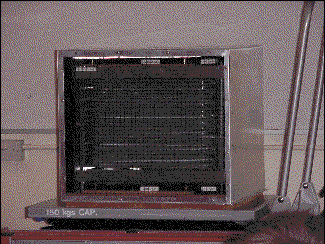Electromagnetic
Interference from the Spark Chamber
For the duration of the sparks in the
chamber (see Why does the spark chamber spark), a large but
short-lived current exists which produces a magnetic field, which in
turn induces an electric field near
to the plates. These fields are
unable to die away (due to Maxwell's fourth equation for fields
which
vary rapidly with time, the equation is omitted here for simplicity as
it is unimportant in the following
discussion); instead, the changing
electric and magnetic fields combine
in such a way as to produce
new fields further out from the plates as the old ones die away.
This process is continually repeated to
give a combination of related electric and magnetic fields travelling
outwards from the plates.
The current within the spark has associated with it's energy, some of
which is dissipated by moving out
with the radiated fields. The
radiated fields become fundamentally different as distance from the
source is increased. In the region close to the spark chamber
the fields are known as 'near fields',
further from the chamber the fields are known as 'far fields'.
The far field is the simpler of the two where the electric (E) and
magnetic (H) components of the field
always have the same relative amplitude (The ratio E/H is known as the 'Impedence of free space' and
has a value of 377 Ohms)
The near field region is the area of
interest. Experimentation has shown that the spark chamber is a
high impedence source
which has the characteristic that it generates
mostly electric fields within the
near field region.
These radiated fields are unwanted as they
are capable of interfering with the operation of other
equipment. This interference is known as electromagnetic interference
(EMI). EMI has been eliminated
from the transportable spark chamber by implementing a shield over the
detector part of the chamber:

Figure 1: Metal shield
over the detector part of the spark
chamber, implemented so as to eliminate EMI
The shield works by attenuating and reflecting the signal as it
tries to pass through the shield.
Reflectivity is the most important of these two when considering high
impedence sources, so a
shielding material of high
conductivity was important.
Return to the
Home Page

